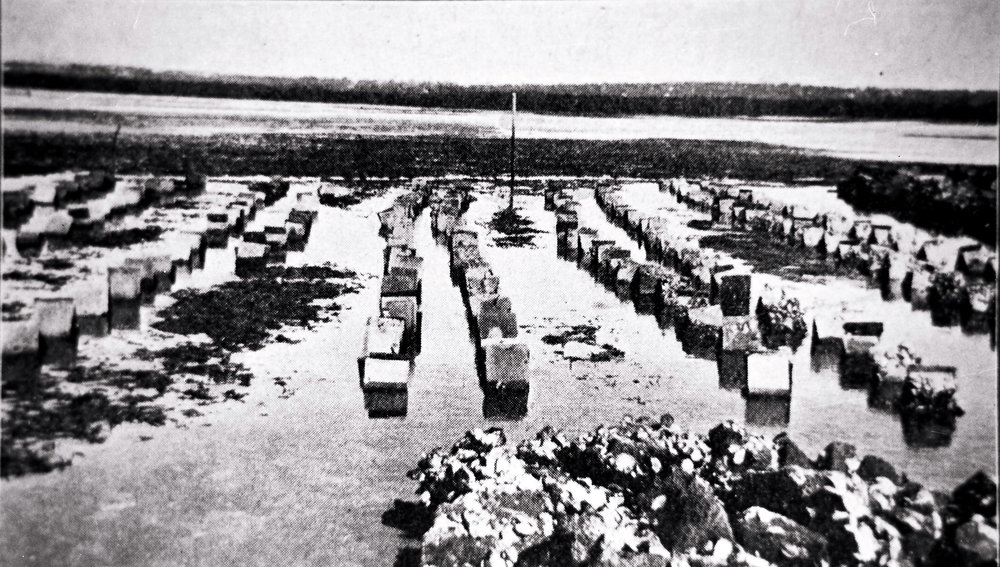
by Thomas Derbes II | Apr 25, 2025
Aquaculture, the cultivation of aquatic organisms such as fish, shellfish, and aquatic plants, has a long and rich history that dates back thousands of years. As global demand for seafood has grown and wild fish stocks have declined, aquaculture has emerged as a crucial solution for sustainable food production. Many might not realize this, but aquaculture is one of the oldest forms of organized food cultivation in human history. This is the first article in a series we are calling Aquaculture 101.
The earliest known records of aquaculture come from ancient China around 4,000 years ago. Carp farming is believed to have begun during the Shang Dynasty (1600–1046 BCE), where farmers began trapping wild fish in ponds created by diverting water from rivers. Over time, they learned to breed, feed, and manage these fish more effectively. A book titled “The Chinese Fish Culture Classic” was written by Fan Lee, a politician turned fish culturist, around 475 BCE and it provides one of the earliest written manuals on fish farming, specifically detailing carp culture. To this day, aquaculture is very popular in China.

An Excerpt From Fan Li’s “The Chinese Fish Culture Classic” Written in 5th Century China – University of Maryland
In ancient Egypt, there are depictions dating back to 2500 BCE that show fish being held in ponds, possibly for controlled harvesting. The Greeks and Romans also practiced rudimentary aquaculture. The Roman naturalist Pliny the Elder wrote about oyster farming in the Mediterranean, which became a luxury industry among Roman elites. Oyster farming is still done in the Mediterranean, especially along the French Coast.
Across the world in ancient Hawaii, native peoples developed highly sophisticated aquaculture systems known as loko i‘a, engineered fishponds that used lava rock walls to trap and rear fish like mullet and milkfish. These systems were integrated with natural tidal flows and demonstrated an advanced understanding of ecology. Hawaii is now a leader in aquaculture innovation, especially in the aquarium trade.

Koi Farming in Japan – Dexter’s World
In Japan, fish cultivation began with the farming of koi and other carp species for food and ornamental purposes. By the medieval period, rice-fish farming, a method where fish were raised in flooded rice paddies, became widespread in many Asian countries. This practice not only provided a secondary source of food but also benefited the rice crops by reducing pests and fertilizing the soil. Japan’s Koi aquaculture is very sacred, and their breeding practices are typically protected with some fish going for over $10,000!
The practice spread slowly to Europe during the Middle Ages. Monasteries in central Europe played a key role in developing freshwater aquaculture, particularly with species like trout and carp. Monks often maintained fishponds to supply food during periods of fasting when meat was prohibited.

Oyster Farming in Wales, 1910 – Sutherland Shire Library
Modern aquaculture began taking shape in the 19th and 20th centuries with advances in biology, chemistry, and engineering. The development of artificial fish breeding, water filtration systems, and formulated feeds greatly enhanced productivity. Salmon farming began in Norway and Scotland in the 1960s and rapidly expanded worldwide. Shrimp farming took off in the 1980s, especially in Southeast Asia and Latin America.
Today, aquaculture is one of the fastest-growing sectors of food production. It now supplies over 50% of the world’s seafood, including fish like tilapia, catfish, salmon, and shellfish such as oysters and mussels. Innovations such as offshore fish cages, recirculating aquaculture systems (RAS), and integrated multi-trophic aquaculture (IMTA) continue to drive sustainability and efficiency.
From its humble beginnings in ancient ponds to high-tech operations across the globe, aquaculture has evolved into a cornerstone of global food security. As the world faces challenges like overfishing, climate change, and a growing population, aquaculture will play an increasingly vital role in feeding the planet. As we continue on our series, we will touch base on the different types of aquaculture found throughout the world and highlight some domestic aquaculture businesses.

by Laura Tiu | Mar 1, 2024
I felt it this morning. That first bit of humidity in the air. That sign that it might indeed be time to move my tropical plants back outside and consider digging in my raised beds this weekend. My seed catalogs are dog-eared, and my local garden store is flush with seedlings. But then I remember, the squirrels, oh how I loath them. They love to thwart all my soil-based gardening attempts, despite my feeble attempts to guard my crops. My option? Return to one of my first loves, aquaponics.
I have been practicing aquaculture as a career for over 30 years and aquaponics for about 15 of those. Aquaponics is a unique food production method that combines aquaculture with hydroponics, or the raising fish with raising plants in a typically soilless system. The fish produce waste nutrients that bacteria in the system convert into a form that the plants can utilize and extract from the water, thereby cleaning the water for the fish. The process is a bit more complex than that and I can spend all day talking about it but that is the short version. Aquaponics can be done in small homemade systems or very large commercial systems. There are hundreds of designs online and you can spend hours online viewing what others have done. My recommendation is to start with the research-based information that you can get for free from colleges and universities and then explore once you are confident in the basics.
In Florida, many types of fish and plants have been successfully grown in aquaponics, however, there are some legal restrictions on some species of fish, so be sure to check before deciding on what fish you will grow. I chose to grow catfish in my system and over the years produced multiple crops and varieties of lettuce, bok choy, pak choy, cherry tomatoes, Swiss chard, basil, turmeric, and snow peas; the sky is the limit.
If you are interested in learning more about aquaponics in Florida, checkout this page on the Florida Sea Grant website: https://www.flseagrant.org/aquaponics-growing-fish-and-food/, or contact me lgtiu@ufl.edu for additional information or to get added to our aquaponics listserv.

by Laura Tiu | Mar 9, 2018

Aquaponic Napa cabbage
There is growing interest in hobby-scale farming techniques. In response to this need, UF/IFAS Walton County Extension Office established a hobby farm featuring a variety of low-input food production options. The farm is a cooperative venture drawing on expertise of the Horticulture, Aquaculture/Marine Science, 4-H, and Agriculture programs. The farm is on a relatively small, tenth acre, plot behind the County Extension Office where staff and volunteers have installed aquaponics and hydroponics systems, honeybee boxes, a chicken coop as part of the 4-H Chick Chain Program, herb garden, raised vegetable bed system, sustainable citrus grove, muscadine grape trellis, shiitake mushroom structure, and blueberry orchard.
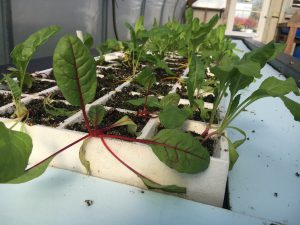
Aquaponic Swiss chard
The aquaponics demonstration system was constructed in 2017 using materials purchased at local stores, Tractor Supply Company and Lowes, or on Amazon.com. The system has a 300 gallon Rubbermaid fish tank that gravity feeds into a 20 gallon plastic garbage can with lid stuffed with bird netting for solids removal and biofiltration. The water then feeds into two 2 ft. x 8 ft. feed troughs with approximately 2 square yards of floating Styrofoam grow beds. Finally the water drains into a 100-gallon sump where it is pumped back into the fish tank. A small air pump provides supplemental air to the fish tank and a small water heater helped maintain temperatures during the winter.
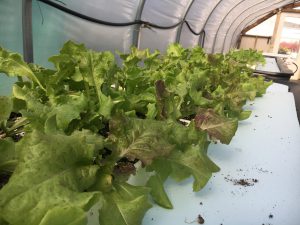
Aquaponic red lettuce
The fish tank is stocked with 18 catfish, originally 4-5 inches, now approximately 10-12 inches, and pushing a half-pound each. The system produced two crops of red and romaine lettuce during the last half of 2017 and is currently planted with romaine and red lettuce, Swiss chard and Napa cabbage. Lettuce is harvested out of the system every five to six weeks, while Swiss chard and Napa cabbage a take longer to reach harvest size.
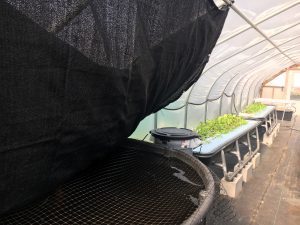
Walton County demonstration aquaponics system.
There is a lot of aquaponics information available on-line. Academic institutions and other research-based organizations are the best places to look for information. The University of Florida has a comprehensive factsheet entitled “A Practical Guide for Aquaponics as an Alternative Enterprise” available at http://edis.ifas.ufl.edu/hs1252. Also recommended is the Food and Agriculture Organization “Small-scale Aquaponic Food Production” manual available at http://www.fao.org/3/a-i4021e.pd.
Aquaponic seminars or webinars are conducted upon request and provide introductory information on a variety of system designs and stocking options. Over 400 visitors have seen the aquaponics and other hobby-scale gardening demonstration plots over the past year, gaining knowledge and acquiring skills to use in their own gardens. If you are interested in a signing up for the aquaponics email listserv, participating in a tour, having a personal consultation or attending a workshop, please contact Laura Tiu, lgtiu@ufl.edu.
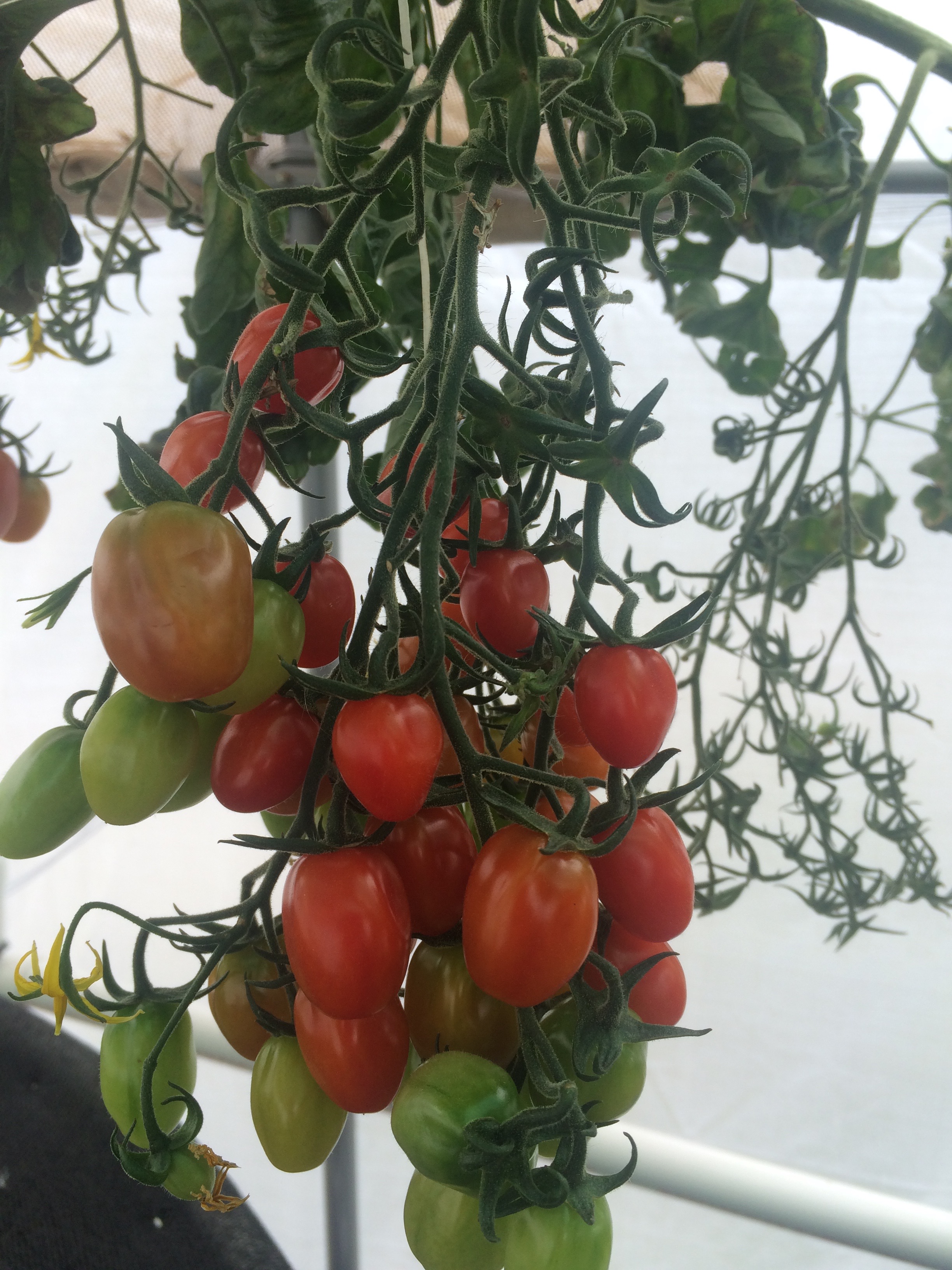
by Laura Tiu | Mar 11, 2017
There has been an increasing demand by clientele for information and training on small-scale food production methods to meet the growing demand for locally produced food and for personal consumption. One of the University of Florida Extension’s high-priority initiatives is “increasing the sustainability, profitability, and competitiveness of agricultural and horticultural enterprises.” One food production method currently being investigated is aquaponics.
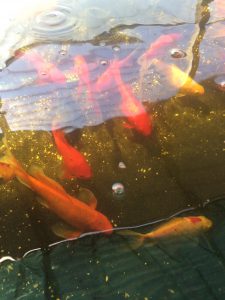
Koi are a popular fish species used in aquaponic systems.
Photo: Laura Tiu
Aquaponics is a technique for sustainable food production that utilizes the combination of aquaculture with hydroponics to grow fish and vegetables without soil. The process begins with fish producing waste, which is then pumped through a bio-filter to convert into fertilizer for the plants. Plants use nutrients from that water, and the freshly oxygenated water is returned to the fish tank. By recirculating the water from the fish tank to the grow bed, the need for water is greatly reduced compared to traditional irrigation. Additionally, producing crops aquaponically can reduce leaching, runoff, and water discharges to the environment by reusing nutrient effluent from aquaculture and hydroponic systems.
For new growers, being able to have access to training and to see a demonstration unit can eliminate many of the pitfalls typically encountered. A small aquaponics system, using local-sourced materials, is being constructed at the Walton County Extension office in DeFuniak Springs, FL. This system will demonstrate the technology and capability of small-scale aquaponics. The system is expected to be operational in April 2017. Working together, the Sea Grant, Horticulture, and Agriculture agents will be able to share construction and operation information with interested clients. Data will be collected from the system in order to give clientele real-world expectations of the operating costs and production potential from the system. Information will be shared in face-to-face interactions, at workshops, via webinar and in published articles. The goal is to see an increase in the number of aquaponics operations in the Panhandle of Florida contributing to an increase in availability of locally and sustainably produced food.
If you would like to see the system or learn more about aquaponics by subscribing to our Aquaponics list serve, please email Laura Tiu, lgtiu@ufl.edu.

Greens tend to do very well in aquaponic systems.
Photo: Laura Tiu
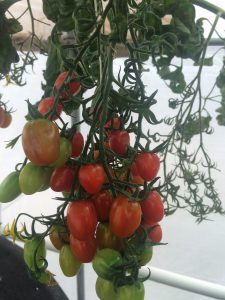
A panhandle favorite, tomatoes can be grown using aquaponics.
Photo: Laura Tiu














